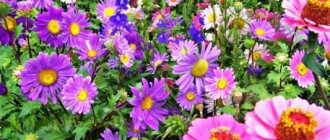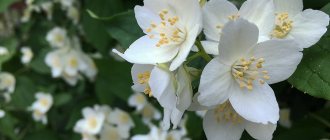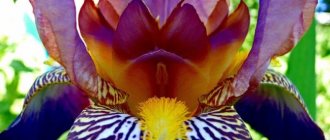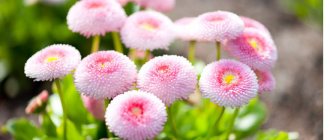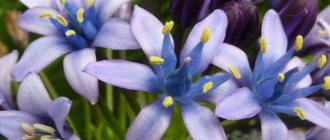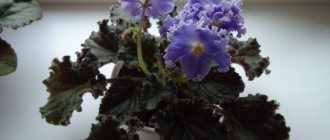-News
—Search by diary
—Subscription by e-mail
-Statistics
Monday, March 23, 2015 12:34 + in quote book
With the appearance of the first flowers in our gardens, real spring begins. These gentle touching creatures, which appear earlier than others, fill the soul of any gardener with joyful awe. I offer a selection of flowers that are the very first to awaken after winter sleep.
1. Snowdrop (galanthus)
This flower is familiar to everyone since childhood. Who doesn't remember the fairy tale "12 months"? These unpretentious, touching flowers with white bell-shaped flowers are among the first to appear in early spring. Snowdrops bloom for about a month, tolerate temperature changes well and are not afraid of early spring frosts.
2. Scilla (scylla)
Scilla is sometimes called blue snowdrop, due to its external resemblance to the latter, and also because it appears as soon as the snow melts. In fact, these are different plants. These blue or dark blue flowers are also not afraid of spring frosts.
3. Hellebore
The name itself suggests that it blooms in the cold. In the south, hellebore blooms in winter, at the end of February. Its buds and flowers are not afraid of either frost or snow.
4. Erantis (spring flower)
These sunny golden flowers will add cheer to a dull spring garden. Erantis also blooms in early spring, in March-April, and is not afraid of frost and snowfall.
5. Primrose (primrose)
There are many varieties of this plant; only a small part of them is grown in culture. Primroses bloom profusely and for a long time in early spring; some species may bloom again in autumn.
6. Lungwort
Lungwort blooms in April-May. Grows well in light, well-moistened soils. After flowering it produces many colorful leaves.
7. Crocus
Bright, low crocus flowers also appear with the first warmth of spring. Crocuses do not bloom for long, only 5-7 days; without transplanting in one place they can grow up to 5 years. There are types of crocuses that prefer to bloom in the fall.
8. Periwinkle
Evergreen periwinkle retains its foliage even under snow. As soon as the soil begins to thaw, it produces new shoots and is covered in soft blue flowers in April.
9. Adonis or adonis
Bright yellow, like little suns, Adonis flowers appear on the very first fine days of spring. They prefer well-lit areas and light, fertile soil.
Spring clearing appears immediately after the snow melts. Its cute yellow flowers fully bloom only in bright sun, that is, in the middle of the day, and in cloudy weather and at night they close.
11. Liverwort
The liverwort is popularly called the coppice, because it does not like open places and grows only in the forest. Her elegant, bright blue lush bouquets are so pleasant to find in the forest after a long winter.
12. Violet
Fragrant violet is a perennial early spring plant. During flowering, the entire area is filled with its aroma. In the south, if there is a warm, long autumn, the violet may bloom again in October-November. And it happens that its flowering continues all winter.
13. Muscari
Muscari or mouse hyacinth is a perennial bulbous plant. Its tiny bell-shaped flowers are collected in racemes of blue, light blue, purple or white, depending on the species. There are also two-colored species of this plant.
14. Whiteflower
Spring whiteflower blooms in April for 20-30 days. The height of the plant is 20-20 cm. Green or yellow spots are clearly visible at the ends of its white bell-shaped flowers.
15. Chionodoxa
Chionodoxa appears in early spring and is also called the snow beauty. The leaves of this plant appear simultaneously with the buds. Flowers can be solitary or collected in small inflorescences. Chionodoxa comes in white, blue, blue or pink.
16. Pushkinia
Pushkinia is a herbaceous bulbous plant 15-20 cm high. The flowers are collected in racemes of white or blue color. Blooms in early spring.
17. Corydalis
An unpretentious frost-resistant plant that blooms in early spring. The height of the corydalis reaches up to 20 cm. After flowering, its above-ground part dies off, after which the plant is not afraid of any mechanical impact, it does not mind trampling or digging.
18. Iridodictium (reticulate iris)
These tiny bulbous irises bloom in April and produce a pleasant scent. They reach a height of 10 cm. They grow well in sunny areas, but also tolerate slight shading.
Tulip
There is a huge variety of species and varieties of this popular flower. Its color can be white, pink, yellow, red, purple, orange and even black. The plant comes from Central Asia, and its name comes from the Persian “turban”, since the shape of the bud is similar to this headdress. The height of the plant can reach 90–95 cm.
Dicentra
This perennial belongs to the poppy family, although it is not at all similar to the mentioned flower. Plants of this genus are famous for their carved leaves and original heart-shaped flowers, which can be white, crimson, pink and red, and bloom from early May to mid-June (and some until autumn).
All types of dicentra are quite frost-resistant. They prefer light, well-drained, moist soil rich in humus; Grow best in sparse shade. After flowering, the aboveground part of both “falls asleep” until spring. Sometimes dicentras bloom again in August-September.
In landscape design, the plant is used to create high borders and rockeries, as well as for single plantings. Dicentra care involves mulching the soil and irregular watering on especially dry summer days.
- Growing dicentra in the garden
Everyone knows this amazing plant with clusters of hearts hanging from the branches. But how to grow it?
Forget-me-not
Forget-me-not is a delicate and charming plant up to 30 cm high. Flowers up to 1 cm in diameter have blue, lilac, white, and violet colors. Forget-me-not is also called “mouse ear”, due to the fact that in some varieties the leaves are covered with dense short hairs and resemble mouse ears. Most often, flowers can be seen in forest glades, but there are also decorative varieties that are planted in the garden.
About the features of cultivation
All primroses have a special development cycle. During the period when all nature is reborn after winter and begins to actively vegetate, they have already experienced the most active phase of their life. This occurs in April-May depending on the type of plant and variety.
Primroses are always planted in open ground in the fall from September to November in order to admire their flowering in early spring. Places chosen are open, drained, and sunny. Suitable areas are between stones, under trees that do not yet have leaves in the spring and the area is completely open to the sun.
Bulbs or plots of perennials are planted with the condition that in the summer their above-ground part will either be completely absent or lose its decorative effect. That is, you need to plant them in groups near summer ornamental plants and shrubs.
In the garden, an interesting option is to plant bulbs in the lawn. In a few years they will grow and will delight the eye with entire flowering meadows.
Primroses are not only beautiful plants, but also very easy to care for. They do not require watering or any agrotechnical measures. It is enough just to feed them 1-2 times a year and plant them if necessary.
Primrose
This is a low, compact plant. Flower growers all over the world love primrose for its bright flowers of a wide variety of colors - white, pink, purple, red, lilac. The center of the flower is most often yellow. The leaves are covered with dense fibers, which is why they appear fluffy and soft.
Flowers in May amaze with their diversity. You can also think of daisy, phlox, aquilegia, alyssum, brunera, swimsuit, poppy, hyacinth, petunia and many others. They are all beautiful in their own way, and each area has its own unique May flower.
Iris (iris)
This perennial rhizomatous plant, whose name translates as “rainbow”, begins to bloom in the middle zone in May. Spectacular graceful flowers, reminiscent of orchids, are distinguished by a rich variety of shapes and shades and are adjacent to the same decorative leaves, sword-shaped, fleshy, dark green. At the same time, there are both tall and completely dwarf forms of irises.
Orcas are characterized by high winter hardiness, they are unpretentious to the soil, but do not tolerate heavily moist soils, so it is better to plant them on slopes and hills. These flowers are grown in one place for up to seven years.
- Iridarium - how to create a beautiful iris garden on your site
Irises in garden design can become the pride of the owner. How to create your own iridarium and care for it so that the charm lasts for months?
Crocus
Although the beauty of the crocus cannot be called particularly elegant or exotic, it is rare that a spring garden composition is complete without these crumbs. The flowers of the plant are single, but sometimes there are specimens with 2-3 stems growing from one corm. Conventionally, all varieties of crocuses are divided into two large groups: blue-flowered (from light lilac to deep purple in color) and yellow-flowered (from pale yellow to orange).
You can distinguish a crocus from a snowdrop and a scilla not only by the color of the flowers, but also by the appearance of the stem. Actually, the latter does not develop in the crocus - flowers and leaves grow directly from the membranous scales emerging from the “spout” of the bulb.
Spring flowers by blooming time
Pansies
Pansies (viola) are the most common flowers in garden landscaping. This is a biennial plant (annual in cultivation). Its maximum flowering occurs in the second year of life. Seeds are sown in the first half of July. By autumn, as a rule, the seedlings are already ready. It is planted in a permanent place at the end of September or early spring. Pansies bloom from early spring to mid-summer. When sown in early spring, viola blooms at the end of summer, but does not bloom profusely. Among the varieties of pansies, the most distinguished are Abendglut (dark red), Mars (dark blue), Himmelkönig (blue), North Pole (white), Helios (yellow), etc. Pansies are most often planted in the form of continuous flower beds, ridges or spots on the lawn.
Arabis alpine
Alpine Arabis, or rhesucha, is a low-growing perennial plant. The flowers are white, simple or double. Stems are semi-recumbent with ash-gray leaves. Arabis blooms profusely, almost completely covering the leaves with white inflorescences, starting in April. Flowering duration is 2-3 weeks.
The plant is very winter-hardy and unpretentious, suitable for planting on rocky hills, ridges, mixborders and along paths.
Propagated in autumn or spring by dividing bushes, early summer cuttings, and seeds. Cuttings take root well after flowering.
Badan
Bergenia, or bergenia, is a perennial plant native to Altai, which determines its high winter hardiness. Bergenia leaves are large, round, shiny, decorative, dark green. The flowers are purple-pink in color, rising 20-30 cm above the leaves on the peduncle. It begins to bloom in the first half of May. Flowering duration is 2-3 weeks. Since there are still relatively few other colors at this time, it seems to fill the “gap”. Propagated by seeds and division of bushes. Sowing seeds - autumn and spring. Dividing bushes is best done in early autumn.
In decoration it is used for planting on ridges, along paths, in groups, mixborders, as a border, as well as on alpine hills.
Periwinkle pubescent
Periwinkle pubescent is a ground cover plant with creeping, weakly branched stems. The leaves are pointed, ovoid in shape. The flowers are solitary, large, violet-blue in color. It blooms from mid-May for 15-20 days.
The plant reproduces vegetatively. Can be propagated by cuttings in July-August.
Periwinkle grows, blooms and is spectacular in neutral, well-drained soils.
Spring whiteflower
Spring whiteflower is found in nature along the edges of beech forests in Central Europe. This is a bulbous perennial up to 20 cm high. The bulb is ovoid in shape. The leaves are broadly lanceolate. Flowers are single or paired, white, drooping, with a pleasant scent. Petals with green or yellow tips. Blooms from April for 3-4 weeks.
The plant has been cultivated since 1420. The most famous variety is Carpaticum. The flowers are large, with yellow spots on the petals.
Brunnera sibirica
Brunnera sibirica is a perennial winter-hardy plant native to Altai. Has large heart-shaped leaves. Blooms in early May (3-4 weeks). The flowers are bright blue, collected in fairly tall clusters, their color reminiscent of forget-me-nots. It propagates well by dividing bushes, which grow very quickly. It is necessary to divide the bushes every 2-3 years, in autumn and spring. But it is best to do this in early autumn, then in spring the flowering will be more complete.
In decoration it is used in groups, at discounts and in mixborders.
Vesennik
Springweed, or erantis, is a plant with yellow, cup-shaped flowers that fill the air with a honey-like aroma. The flowers are solitary, appear in early spring (April-May), breaking through the snow, and bloom for up to 8 weeks.
Hyacinth
Hyacinth is a perennial bulbous plant that can be grown both in open ground and indoors. Found naturally in the Mediterranean and the Middle East. There are more than 30 wild species.
In central Russia, hyacinths begin to bloom in early May, which coincides with the flowering of early varieties of tulips. Flowering duration is 25 days.
The disadvantage of hyacinths is that they are not winter-hardy and in the conditions of central Russia they require shelter for the winter.
Iris reticulum
Iris reticulum is a fragrant purple flower. This is the earliest type of irise.
The flowering period lasts from late February to early April.
There are varieties with flowers of white, yellow and light blue. The leaves are tender and herbaceous.
Crocus
Crocus, or saffron, belongs to the group of bulbous early spring plants. It blooms a little earlier than daffodils and tulips. But the flowering time is only 8-10 days.
The plant reproduces by bulbs, and planting and caring for it are similar to tulips. But unlike tulips, crocus bulbs are planted somewhat denser and at a shallower depth, taking into account their size.
Daisies
Interspersed with daisies will help give lawns a very unusual, star-shaped appearance. To do this, flower seeds are sown simultaneously with sowing lawn grasses or later. They bloom during May-June.
Daisies are good for planting along paths, in the form of borders.
The plant self-sows, so it blooms annually.
Daisy seeds are sown on the ridges in July and then planted. They are planted in a permanent location in September or early spring.
Lungwort angustifolia
Lungwort blooms in the garden in April-May. Flowering duration is 3-4 weeks. Its bright purple-pink buds and half-open flowers look very beautiful. Especially against the backdrop of green foliage.
Lungwort grows well in moist soil and is demanding of fertilizers. Propagated by seeds and division of long rhizomes. Collecting lungwort seeds is quite difficult, as they ripen slowly and fall off almost immediately.
Narcissus
Daffodils bloom almost simultaneously with tulips. Flowering duration is 2 weeks. These are beautiful, usually white flowers that attract attention with their grace. Some varieties of daffodils have a pleasant, subtle aroma. Of the many groups of daffodil varieties in our conditions, the most stable are the so-called poetic ones.
Rusty-spotted sedge
Rusty-spotted sedge is a suitable plant for borders as it holds edges well. Blooms in April (3-4 weeks) with bright pink flowers. Sedge grows very slowly and forms a cover up to 20 cm high. The decorative value of the plant increases during flowering.
Propagated by seeds and dividing the bush in August.
Primrose
The large-cupped primrose, or primrose, is a plant approximately 10-20 cm high, with bright yellow flowers collected in an umbellate inflorescence. Blooms in late April - early May. Flowering duration is 3-4 weeks.
The plant propagates by dividing the bush and seeds. Grows well in shade and open sunny areas.
Common snowdrop
Snowdrop is a low, modest plant that is the first to appear (March-April) after winter in our gardens. Flowering time is 3-4 weeks. It first produces a pair of linear leaves, and then blooms with drooping white bells. He is not afraid of snow and spring frosts.
Snowdrop is one of the earliest flowering plants, sometimes breaking through the layer of snow.
Primrose ground
Ground primroses are perennial winter-hardy plants. They begin to bloom in May (4 weeks). They have a wide variety of colors.
The most common types of primroses are serrated, tall and auricula. They are propagated in two ways: by seeds and by dividing bushes. Seeds are sown in early spring, and the bush is divided in August-September.
Primroses do not like bright sunlight, preferring partial shade. It is best to plant them next to shrubs and trees.
Tulip
There are more than ten thousand varieties of tulips in the world's assortment. They differ in color, height, flowering time and other characteristics.
The varieties bred in Holland are especially beautiful: Bolshoi Theater, London, Parade. They are distinguished by bright red, very large flowers. The varieties of domestic selection are no less beautiful: Garnet bracelet, Violet glass, Effect, Raspberry ringing.
The tulips of the Tashkent Botanical Garden are the first to bloom in April (Lyubov Shevtsova, March 8 and Sunrise). Then come the later varieties: Dillenburg, Yunms, Alaska. They begin to bloom at the end of May. The flowering time of each variety is 10-15 days.
With the correct selection of early and late varieties, you can have blooming tulips for 1.5 months.
To get the maximum decorative effect, you can plant groups of single-varietal tulips of different sizes depending on the area of the flower garden. Blooming tulips look especially good against the background of a lawn.
They go well with forget-me-nots and pansies.
To ensure that there are no voids left in the flower garden after flowering, seedlings of annual summer-blooming plants are planted in their place.
Phlox soddy
Phlox turf is a perennial herbaceous plant. It has hard subulate-shaped leaves that densely cover the recumbent stems, forming a dense carpet 10-12 cm high. Phlox begins to bloom in May with numerous star-shaped flowers of pink, blue and white colors. Flowering duration is 30-40 days, in some cases slightly longer. After flowering, the plants do not lose their decorative properties, thanks to the carpet formed by dark green leaves.
The advantages of this plant: winter hardiness, drought resistance, ease of care, ability to tolerate bright sun and partial shade, ease of reproduction, rapid growth. Phlox propagates mainly by early summer cuttings of stems, less often by dividing bushes.
In decoration it is used to create perennial carpets, lawn stains, borders, and also in rocky flower beds.
Chionodoxa
Chionodoxa, or snowman, is one of the first spring flowers. It comes in several color options, and each has its own characteristics. The plant is characterized by exceptional winter hardiness. It is easy to grow.
Chionodoxa are not tall and are found in nature in the mountainous regions of Asia Minor and southern Turkey. Blooms in early spring (April-May). Flowering duration is 2-3 weeks. There are 10-15 wide bell-shaped flowers on a thin stalk of a peduncle. During flowering, it appears as a lush “basket” filled with flowers and lined with bright emerald-colored leaves.
➣ Turf phlox, bergenia, arabis alpine, and brunnera sibirica still occupy an insignificant place among spring flowers, but they deserve attention. Distinctive features of these plants are exceptional winter hardiness and early flowering.
Narcissus
A common monocotyledonous plant of the Amaryllis family. From a botanical point of view, it is a herb with a bulbous root system. It does not form leaves; the bush is represented by several thin stems on which flowers appear. They have a pleasant aroma and a recognizable star-shaped shape. Typically the petals are white with a bright yellow center.
All species of this genus are poisonous and contain a strong alkaloid. In ancient times, essential oil for perfumery was made from the roots; today it has been replaced by cheaper synthetic analogues. It looks decorative when planted in groups; it can be grown as a potted crop.
Delicate snowdrops - the awakening of nature
The Slavic legend says how one day the old woman Winter decided not to let Spring come to earth. The flowers drooped from fear, one snowdrop was not afraid and opened its petals. The sun saw him, warmed everything on earth with its warmth and cleared the way for the beautiful Spring. Since then, spring and snowdrops have been inseparable.
The first flowers of spring, which in many areas are also called snowdrops, are nothing more than dream grass, corydalis or lumbago. They say that once upon a time the leaves of the lumbago were so large and wide that Satan, who was expelled from paradise, could hide behind them. But the Archangel Michael, discovering his hiding place, threw an arrow at him. And the leaves of the dream grass remained shot through - cut into thin slices. The lumbago also blooms even at sub-zero temperatures. The whole secret of this, it turns out, is in the cup of the flower. It, like a concave mirror, collects the sun's heat. And the temperature inside the cup is +8 degrees.
Legends and interesting facts about garden primroses
Botanists call this flower galanthus; it is popularly known as snowdrop. In France it was called the snow bell; the British call these primroses snow drops. There is also a beautiful legend about this impatient representative of the flora, opening its bud among the snow in a small thawed patch.
An ancient legend says that in time immemorial, the goddess of plants Flora decided to organize a magnificent carnival. She prepared a festive outfit for each flower. For the galanthus, she chose a snow-white robe. Snow also wanted to come to this celebration. But the goddess decided that such a guest was not suitable for delicate flowers and refused him an outfit. Snow asked the participants to share their outfit with him. But the flowers, fearing the cold, refused. The little galanthus was not afraid and covered him with her snow-white robe. Since then, as a sign of gratitude, snow has protected the flower from frost. This is how they maintain their friendship: delicate galanthus and snow.
In France, galanthus is called snow bell
In the first weeks of spring, beautiful buds bloom on the hellebore. The homeland of this popular garden perennial is the Caucasus ranges. In these regions, under natural conditions, it begins to bloom in February. According to legend, this flower was first discovered next to the stable where the newborn Jesus Christ lay in a manger. Therefore, hellebore has another name - “Rose of Christ”.
The homeland of hellebore is the Caucasus ranges
Crocuses are rightfully considered a symbol of spring. It is believed that it is by the appearance of the blossoming buds of this plant that one can judge its arrival. In Ancient Greece, the crocus was called the flower of Aurora, the goddess of the awakening of nature, the dawn. There is a beautiful legend about this primrose. In the spring, Hera and Zeus met on a picturesque river bank, and a strong feeling flared up between them. The heat of their passion awakened the earth from sleep, and the clearing in which the lovers were bloomed with purple and white buds. There are poetic descriptions of the crocus in Eastern epics. Ancient poets said that thanks to this flower one can imagine the main beauties of the world: the mysterious yellowness of the moon, the heavenly noble blue, the pink tenderness of the morning dawn, the mysterious red-purple twilight.
Crocuses are rightfully considered a symbol of spring.
Among the primroses is the favorite flower of bees - lungwort. This amazing plant is covered with inflorescences in two shades: dark blue and pink. An ancient legend claims that God created the lungwort as a symbol of the unity of man and woman. Blue buds are the flowers of Adam, pink ones symbolize Eve. Scientists do not believe legends; only the results of laboratory research are important to them. When studying the structure of the lungwort, they discovered that the shade of the buds depends on the degree of acidity of the cell juices. In a young plant it is high, which gives the flowers a pink color. Over time, the indicator decreases, the petals of the inflorescences acquire a blue tint.
Bees' favorite flower is lungwort
Many people know the famous legend about the narcissistic Narcissus. The Ancient Greeks associated this primrose with vanity, cold beauty, and selfishness. In ancient Rome, yellow daffodils were intended for triumphants who won a battle. This flower was highly valued in Ancient Persia. It was considered a symbol of the beloved's eyes.
In ancient Persia, the narcissus was considered a symbol of the eyes of a beloved
Periwinkle in many countries was the favorite flower of witches and witches. He helped girls find out about upcoming marriages and protected houses from lightning strikes. It was believed that periwinkle flowers should be collected from the Nativity of the Virgin Mary to the Assumption, dried and hung over the door. They will not allow evil spirits to enter the house. The ancient Celts called the flower a witch's violet, considered it the most powerful amulet, and always carried dried periwinkle with them.
The ancient Celts called periwinkle the witch's violet.
When choosing bulbous flowers and perennials for your garden, you can remember ancient legends and decorate your flower beds with symbols of love, beauty, and kindness.
Hyacinth – the flower of fidelity, happiness and sorrow
Another spring flower is hyacinth. Its multi-colored sultana inflorescences appealed to many gardeners. Hyacinth is a flower of fidelity, happiness and sorrow. And, of course, he has his own legend.
The god Apollo had a favorite on earth - a simple boy named Hyacinth. They often started sports competitions. Once Apollo threw a disk, and it flew towards Hyacinth. Splashes of the young man's blood sprinkled the grass, where lilac-red flowers soon grew, which the ancient Greeks called hyacinths.
The flower quickly spread throughout the world and, thanks to its beauty and aroma, became a favorite in many countries. Only in France in the past was hyacinth used “for showdowns” in palace intrigues. Flowers sprayed with poison were placed in the victim's boudoir. The poison, together with essential oils, penetrated the human body and killed him.
If you look closely, you will see that the hyacinth inflorescence consists of many miniature lilies. During its “cultivation,” the range of colors and shades expanded, and terry hyacinth was bred through selection.
Iridodictium
If you want to add a little more variety to the look of your spring flower beds with something more sophisticated and sophisticated, look no further than Iridodictium. This flower is so similar to its older brother the iris that it is very difficult to confuse it with any other primrose.
Iridodictiums are low 10-15 cm plants with 5-7 cm flowers that are quite large for their size. A characteristic feature of this decorative crop is that the narrow, hard leaves of iridodictium appear simultaneously with the buds. Only one flower opens on each plant. It can be white, yellow, lilac, violet or blue.
- Bulbous irises: all about proper planting and care
Iridodictium, juno and xyphium are unusual irises for an interesting garden.
Transformation of conifers in May
Towards mid-to-late May, the transformation of conifers . Contrary to the well-known mystery, the appearance of conifers is very changeable. And evergreen beauties become especially elegant in late spring and early summer. Even in ordinary non-varietal spruce trees, young branches have a lighter color and stand out noticeably against the background of old needles.
During this period, young conifer buds are just beginning to bloom and look like charming buds. The varieties with contrasting bright growth are especially elegant in early May. For example, the Canadian spruce "Rainbow End" and "Daisy White" have yellowish young shoots. Similar varieties can be found in blue spruce . the spruce “Maigold” and “Bialobok” have golden young needles against the background of the usual bluish needles .
In classic varieties of prickly spruce, the young growth is no less attractive, because, as a rule, it has a brighter blue color. of common spruce “Ridal” and “Kruenta” are famous for their truly unique red growth .
, all types of pines appear with their own decorations - brown vertical candles of young growth.
Canadian spruce "Rainbow End". © Lyudmila Svetlitskaya
Muscari (viper onion, mouse hyacinth)
Muscari bulbs planted at the beginning of autumn are already overgrown with “babies” by spring, so in April a thick curtain of these unpretentious plants forms at the planting site. Muscari could be confused with hyacinth, if not for the size (hyacinths are noticeably larger) and the shape of the inflorescences. Hyacinth's inflorescences are more like bells, while muscari's inflorescences resemble open barrels. These plants also differ in the shape of the brush - in hyacinth it is rather cylindrical, and in muscari it is cone-shaped.
